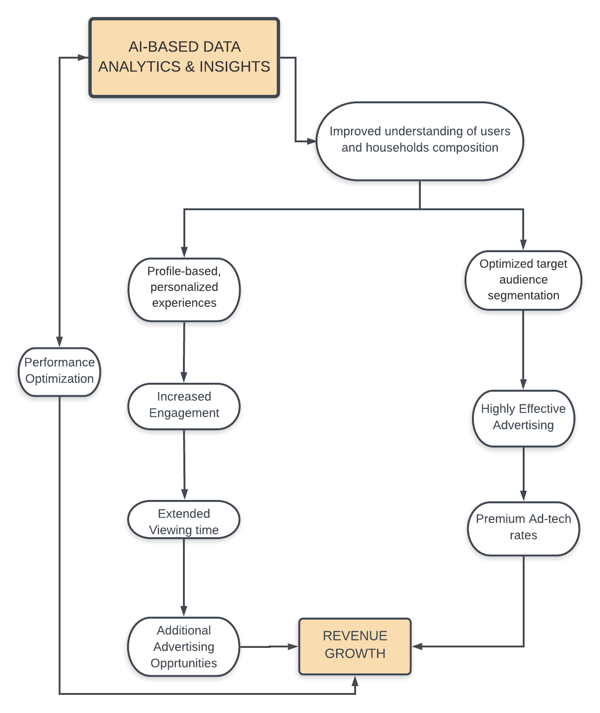While deployment of Targeted TV Advertising, AKA Addressable TV Advertising solutions, is ramping up across the industry, its power is truly unlocked once AI is used to extract cross-system insights.
 Targeted advertising holds a significant monetization opportunity for today’s Pay-TV operators. If we look at the VO Targeted TV advertising solution, we see that it enables them to diversify their revenues and launch new services in an effort to mitigate revenue stagnation and cope with the industry’s main challenges of recent years.
Targeted advertising holds a significant monetization opportunity for today’s Pay-TV operators. If we look at the VO Targeted TV advertising solution, we see that it enables them to diversify their revenues and launch new services in an effort to mitigate revenue stagnation and cope with the industry’s main challenges of recent years.
Other factors include the drop in subscription prices, the rising cost of content rights, and the loss of their traditional role as home network providers due to growing cord-cutting and cord-shaving trends, which are expected to intensify with 5G.
Targeted TV Advertising increases both the yield and revenue for the same inventory. For example, instead of running two commercials in a one-minute break, operators can run 10 commercials, each targeting a different, highly relevant audience segmented via their own usage data.
Furthermore, utilizing artificial intelligence with TV and first-party data can provide invaluable insights into viewers’ preferences, behavior, and household composition, enabling operators to personalize both their content offerings and advertising, thus creating highly engaging, profile-based viewing experiences alongside highly rewarding audience segmentation.
Inventory or non-inventory? It doesn’t matter
Targeted TV Advertising holds great opportunities for all kinds of operators, from the largest to the smallest, and whether they have a pre-existing inventory or not. VO Targeted TV Advertising solution, for instance, provides a unified platform to serve advertising for Live, VOD, cloud DVR, OTT, IPTV, cable, satellite, networks — you name it! — on STBs and connected devices.
The key is that beyond the ability to manage it wisely and effectively, operators with an existing inventory can boost their reach and overall revenues through AI-based insights and analytics, which enables them to not only optimize performance but also to actually extend viewing time through the increased engagement afforded by the analytics.
In other words, AI-based insights help operators better understand user behavior and preferences, enabling them to optimize their ads in real time and target specific—and local—audiences and creating additional opportunities to show targeted ads to their increasingly engaged viewers.
For operators without an inventory, the Targeted TV advertising solution provides the opportunity to use the ready-made, off-the-shelf smart infrastructure to connect with various TV channels and support multi-ad servers. This allows them to leverage their existing first-party usage data to offer highly attractive and equally rewarding segmentation while extending their ability to support and measure ad-insertion.
Challenges in delivery
One of the main challenges of advertising-based services is, first and foremost, maintaining user satisfaction. The solution is aimed at increasing revenues without causing user frustration by closely monitoring exaggerated ad load. Indeed, using the addressable TV advertising model enables the reduction of ad loads, which contributes to higher user satisfaction and reduces churn.
The second challenge, as with anything related to data, is obviously data privacy. Protecting viewers' data in compliance with the GDPR and other privacy-related legislation initially seems to be a challenge, but for TV operators, it is actually an opportunity. As TV is a close and controlled trusted environment by viewers and advertisers alike, operators have the edge to ensure that no personal data is being shared, keeping operators in full control over data at any given time via the right set of tools.
Moreover, the GDPR and similar privacy regulations have increased the value of first-party data tremendously due to the lack of data availability and accompanying consent management requirements. TV operators have an advantage in these two areas, as they are both trusted by their users and in daily communication with them, which enables them to capture consent with relative ease.
Further challenges include maintaining frame accuracy, establishing connections with multiple advertisers, handling linear peak viewing, and supporting legacy components. To be successful with Targeted TV Advertising, operators need to choose a solution that fully addresses all these and much more while also being their bridge between the digital world and their own platform.
How AI helps operators to optimize their service
AI tools are holding a prominent role in optimizing targeted TV advertising for cable and broadband operators. The following flow chart helps define its multi-purpose role.

Put simply, the AI-based insights are the primary wheel driving the whole process into motion; the Embedded AI algorithms produce valuable, in-depth insights on viewer’s behavior and preferences, resulting in highly-profitable segmentation, including household composition, personal interests, life moment events, and more. There are several different categories of insights:
- User Preferences: WHAT do viewers like? These are the insights regarding the interests of the individuals inside a given Household. For example, Real Madrid fans, gadget seekers, tech-savvies, foodies, etc.
- User Behavior: the ‘WHERE’ and ‘HOW’? These insights involve the way in which the content is being consumed. For example, through which devices? At home or on the go? Do they indulge in binge-watching etc…
- Household Composition: a collection of insights on the way a household is structured: how many viewers there are, what their current life stage is (a young family or an elderly couple, etc.) Ultimately, this insight answers the question ‘WHO’ is using the device?
- User Exposure: an important insight particularly for big brands, and a place for collaboration between traditional linear TV advertising and targeted advertising, empowering brands to target potential customers based on their previous exposure to a specific campaign.
- Life Moment Events: Events that significantly change an individual's or a family's life can also be identified via AI — for example, the birth of a new child, a person’s retirement, graduation, relocation, etc. — enabling more accurate and relevant advertising.
AI’s Key Role in Addressable TV Advertising
The aggregation of usage data into a holistic overview of users and its transformation into highly specific segments is enabled through ML and AI, which are what empower providers to interact with the ad-tech ecosystem on premium revenue-share rates.
At VO, our actionable insights are based on heavy AI and ML capabilities that we have developed throughout the last decade. We constantly update our research and algorithms and evolve with the times.
We also use AI to draw insights into the effectiveness of various content sources, enabling personalized and measurable content discovery for maximum user satisfaction and improved content acquisition.
All in all, the data-driven AI analysis of usage flows and consumption patterns enables continual performance optimization and effective segmentation, empowering operators to deliver superior user experiences while maximizing their service monetization and boosting their ROI.
More about: Addressable TV advertising <<

